Category — Medieval Art
The Book of Kells in the News
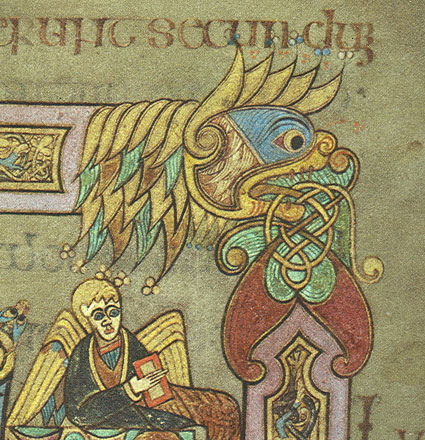
There may be no more famous example of an illuminated manscript than the Book of Kells. While it is well known as one of the most beautiful surviving illuminated manscripts, surprisingly, very little is actually known about the manuscript and its origins. Finally, modern science will be used to learn more about this treasure. From the Dublin Journal as reported in the New York Times:
Experts at Trinity College in Dublin, where the Book of Kells has resided for the past 346 years, are allowing a two-year laser analysis of the treasure, which is one of Ireland’s great tourist draws.
The 21st-century laser technology being used, Raman spectroscopy, encourages hopes among those with a romantic view for an ecclesiastical intrigue like “The Da Vinci Code†or “The Name of the Rose.â€
But the precise subjects are more mundane. The laser will study the chemicals and composition of the book, its pigments, inks and pages of fine vellum. Experts estimate that 185 calves would have been needed to create the vellum on which the art and scriptures were reproduced.
This news happens to coincide with the opening of The Medieval Scriptorium’s on-line gallery of images from the Book of Kells. I have to admit that the gallery is not complete. I haven’t had time to finish all of the captions for the images but I decided to introduce it in this post in light of the recent story referenced above.
[tags]Book of Kells, illuminated manuscript, celtic, calligraphy[/tags]
May 29, 2007 1 Comment
The Bedford and Sobieski Books of Hours Now on Display at the British Library
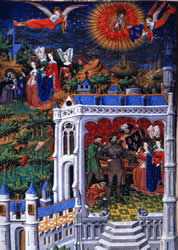 The Bedford Book of Hours is going to be on display at the British Library next week. This is one of the most magnificent illuminated manuscripts in the world. It dates from the early 15th century and every single page in the over 500 hundred page book of hours is illustrated. The illustrations and illuminations are vivid and lush. On display with the Bedford Hours is the Sobieski Hours. It is also from the early 15 century. Both illuminated masterpieces are credited to an artist known as the “Bedford Master.” From the 24 hour museum:
The Bedford Book of Hours is going to be on display at the British Library next week. This is one of the most magnificent illuminated manuscripts in the world. It dates from the early 15th century and every single page in the over 500 hundred page book of hours is illustrated. The illustrations and illuminations are vivid and lush. On display with the Bedford Hours is the Sobieski Hours. It is also from the early 15 century. Both illuminated masterpieces are credited to an artist known as the “Bedford Master.” From the 24 hour museum:
The British Library is displaying two masterpieces of medieval art together for the first time in an exhibition celebrating the 15th century artist, the ‘Bedford Master’, and the collections of the manuscript owners.
Running until July 2 2007, The Bedford Hours: Owners and Illuminators, brings the Bedford Hours and the Sobieski Hours together, both lavishly illustrated medieval manuscripts by the Bedford Master (so called in honour of his noble patron the Duke of Bedford).
The 24 hour museum continues:
The identity of the Bedford Master remains uncertain, despite his having been among the leading and most prolific painters of his day. Some scholars tentatively identify him as the Alsatian artist Haincelin of Hagenau, recorded in Paris as a court painter to the Dauphin Louis de Guyenne.
This may very well be a once in a lifetime opportunity to see the very best examples of Gothic Parisian illumination. These books are the pinnacle of Gothic calligraphic art.
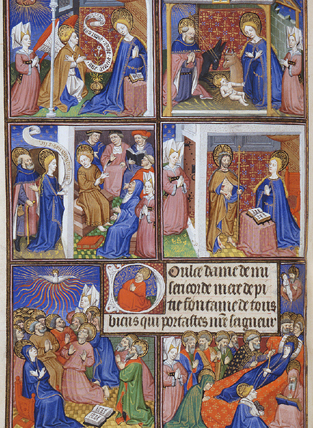
[tags]illuminated manuscripts, book of hours, bedford hours, sobieski hours, gothic alphabet, gothic calligraphy, british library[/tags]
April 16, 2007 Comments Off on The Bedford and Sobieski Books of Hours Now on Display at the British Library
The Book of Deer – Celtic Illuminations and the Oldest Known Gaelic from Scotland
 One of the most interesting Celtic manuscripts is The Book of Deer. It dates from the 10th century and is the earliest manuscript from an area of Scotland known as “former Pictland”. The Book of Deer is considered particularily important for the notes written in Gaelic in the margins of the original text. The Gaelic “scribbles” are the earliest record of written Gaelic from Scotland. From The Book of Deer Project web page:
One of the most interesting Celtic manuscripts is The Book of Deer. It dates from the 10th century and is the earliest manuscript from an area of Scotland known as “former Pictland”. The Book of Deer is considered particularily important for the notes written in Gaelic in the margins of the original text. The Gaelic “scribbles” are the earliest record of written Gaelic from Scotland. From The Book of Deer Project web page:
The Book of Deer is one of Scotland’s most important manuscripts. It is a small (54mm x 107mm) Gospel Book, now housed in Cambridge University Library. Before c. 1100 it was apparently in the possession of the early Columban monastery at Old Deer in north-east Aberdeenshire. This monastery has otherwise left no trace of its existence. A Cistercian Abbey was founded nearby in 1219. The Book of Deer came into the ownership of Cambridge University Library in 1715, when the library of the Bishop of Ely and Norwich was presented to the former by George I. Before that, the Book of Deer may have been in the possession of Dr Gale, High master of St Paul’s School (1672-97). The stages by which it moved from the North East of Scotland to the South of England are by no means clear. Even Cambridge University Library was unaware of its significance until it was ‘discovered’ in 1860 by the then librarian, Henry Bradshaw.
More information and images are available on The Book of Deer web page.
March 31, 2007 Comments Off on The Book of Deer – Celtic Illuminations and the Oldest Known Gaelic from Scotland
Joan of Arc at the Corcoran Gallery of Art in Washington, DC
 From November 18, 2006 through January 21, 2007, the Corcoran Gallery of Art in Washington, D.C. is presenting an exhibition on Joan of Arc (ce 1412-1431). There aren’t many historical figures with a more interesting resume than Joan of Arc. What’s more fun than a cross-dressing religious fanatic warrior who is burned at the stake and later made a saint. It’s good stuff and it has been an artistic inspiration for many over the centuries. From the gallery web site:
From November 18, 2006 through January 21, 2007, the Corcoran Gallery of Art in Washington, D.C. is presenting an exhibition on Joan of Arc (ce 1412-1431). There aren’t many historical figures with a more interesting resume than Joan of Arc. What’s more fun than a cross-dressing religious fanatic warrior who is burned at the stake and later made a saint. It’s good stuff and it has been an artistic inspiration for many over the centuries. From the gallery web site:
The exhibition surveys more than 200 French and American works produced over five centuries, including paintings, sculpture, illustrated books and manuscripts, textiles and popular art on loan from major institutions, including the Metropolitan Museum of Art, the National Gallery of Art, the John and Mable Ringling Museum, the Library of Congress, Harvard University, the Boston Public Library and Columbia University. These varied loans contextualize Boutet de Monvel’s Joan of Arc works in the Corcoran’s collection.
This represents a unique opportunity in the Washington, D.C. area to see illuminated manuscripts from a variety of institutions. In addition, it’s interesting to see the form that the Joan of Arc story has taken over the centuries.
[tags]illuminated manuscript, Corcoran Gallery of Art, Joan of Arc, medieval history, 15th century[/tags]
November 24, 2006 Comments Off on Joan of Arc at the Corcoran Gallery of Art in Washington, DC
Missing Fra Angelico Panels Found in Spare Room
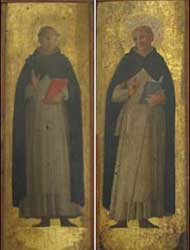
In 1439, Fra Angelico, a monk and well respected Renaissance artist, painted two panels depicting a pair of medieval saints. They were part of the alter of the convent and church in San Marco, Italy. In all, there were eight panels in the alterpiece. The paintings were dispersed during the Napolenoic wars. Since then, six of the panels have been found but the two shown to the left were missing until recently and their whereabouts was considered one of the great art mysteries.
Moving forward in time to the the 1960s, a young Jean Preston was employed in California as a manuscript curator and saw two panels that she adored. Using all of her charm, she convinced her art collector father to purchase the paintings. They were bought for a few hundred pounds. From The Independent:
Jean bought the paintings because she thought they were rather nice. Someone came in with a box of things they wanted to get rid of. None wanted them but she was a medievalist and actually thought that they were quite nice. When I used to stay with her I slept on a sofa bed underneath the paintings. Who would have thought she had the equivalent of a winning lottery ticket in her spare room all these years?
The paintings were hung in the retired 77 year old Ms. Preston’s home behind the door to the guest bedroom.
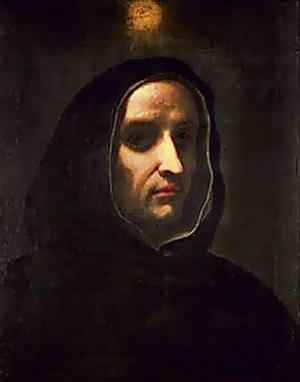
Fra Angelico was originally commissioned by Cosimo De Medici, one of the greatest art patrons of the Italian Renaissance, to create an altarpiece for the high altar at the church and convent of San Marco in Florence, where he lived.
The paintings were recognized shortly before the death of Ms. Preston and are expected to bring over $2 million at auction. Was Ms. Preston dismayed with her fortuned hanging on the walls of her spare room unrecognized all of these years? According to Michael Liversidge as quoted in The Independent:
“She knew they were good paintings but had no idea what they were. When I told her the news, she was pleased that her “eye” had been correct,” he said.
[tags]Fra Angelico, medieval art, renaissance art, art mystery[/tags]
November 18, 2006 Comments Off on Missing Fra Angelico Panels Found in Spare Room

